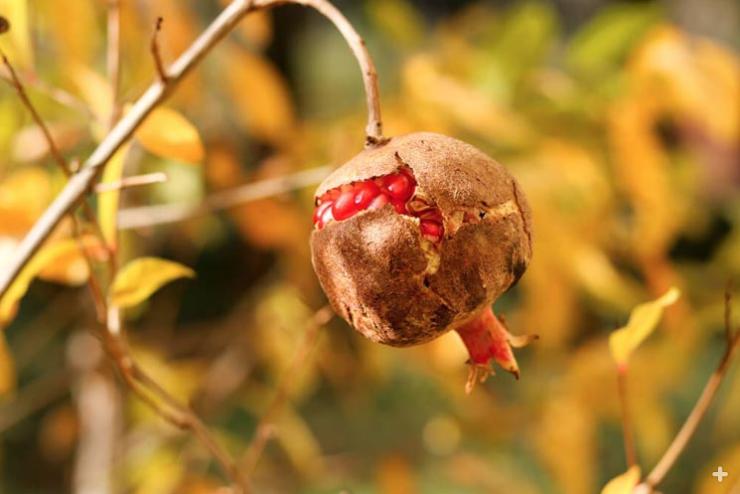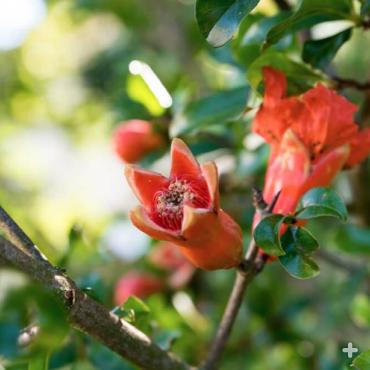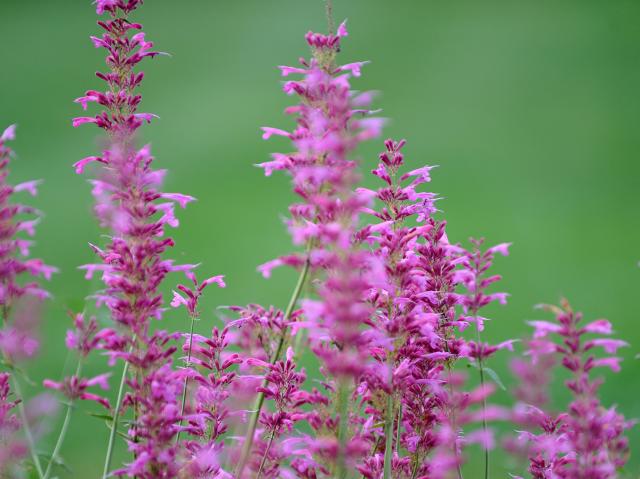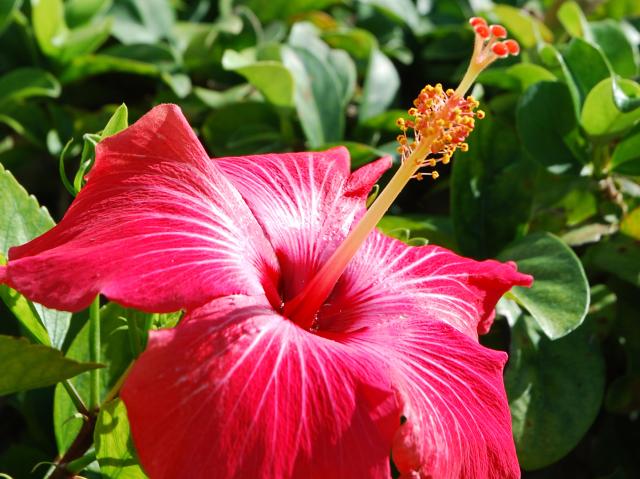
Pomegranate

- Division: Tracheophyta
- Class: Magnoliopsida
- Order: Myrtales
- Family: Lythraceae
- Genus: Punica
- Species: granatum

An Ancient, Ruby-red Prize
The pomegranate is an ancient plant that was cultivated and highly prized by civilizations dating back beyond 3500 BC. In fact, the Sumerian queen Kubaba was often shown in stone carvings holding a pomegranate fruit, a pomegranate-shaped silver vase and a painted ivory pomegranate spoon were found in King Tut’s tomb, and remnants of pomegranates were found in the ash in Pompeii. Throughout its long history, the pomegranate has been depicted in art, literature, and religious ceremonies as a symbol of eternal life, fertility, abundance, strength, and good luck. To this day, pomegranates are featured in festivals, ceremonies, and traditions worldwide, and the fruit’s beautiful seeds are used in cuisines as varied as Greek, Middle Eastern, Spanish, and Chinese.
The word pomegranate comes from two medieval Latin words: pomum, meaning “apple,” and granatum, meaning “seeded.” The tree’s genus name, Punica, refers to the Phoenicians, a Mediterranean civilization credited with spreading pomegranates to far-away lands through their extensive trading routes. Although pomegranates are thought to be originally native to the region from Iran to northern India, they grew well in the Mediterranean and other warm-weather climates, and soon naturalized in many other parts of the world—including, eventually, the southeastern and southwestern United States.
Characteristics
The pomegranate is a shrub or small tree that reaches 6 to 20 feet (2 to 6 meters) in height (occasionally as high as 30 feet, or 9 meters). Although mostly cultivated for its round, red fruit, some fruitless pomegranate varieties are grown as ornamental plants for gardens and landscaping. The tree has multiple spiny branches with a graceful, drooping habit, along with abundant, glossy green leaves and cheerful, orange-red flowers.
Leaves
The leaves are narrow and pointed, up to 4 inches (10 centimeters) long, and grow in a whorl formation along the branch. The shrub or tree is deciduous in most climates (although evergreen in the tropics), and the leaves turn yellow in the fall before dropping from the tree. Pomegranates can be extremely long-lived: some specimens in France are known to have survived more than 200 years.
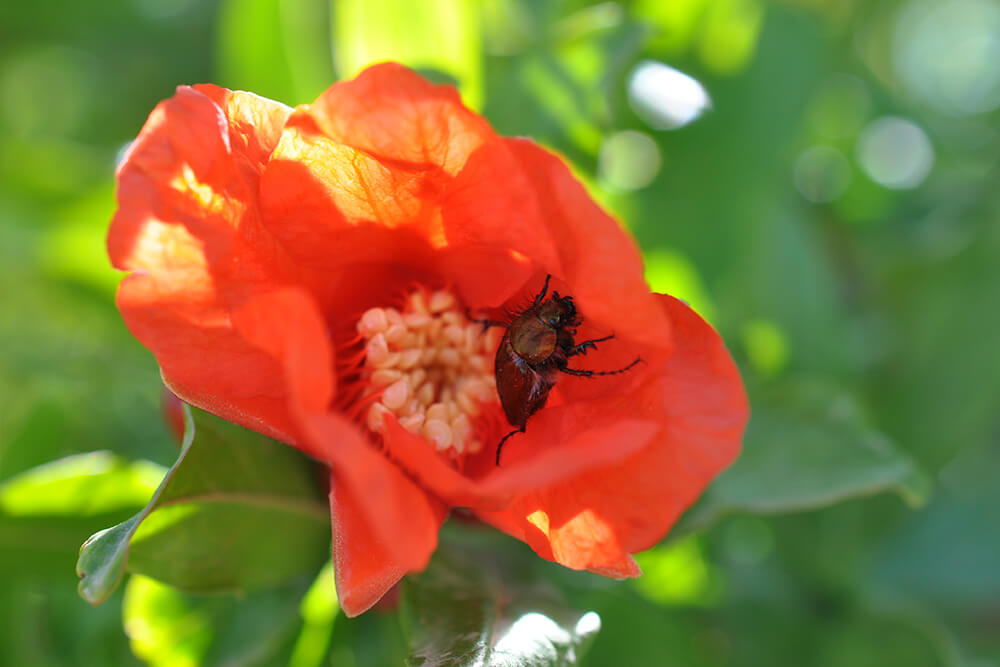
Flowers
Pomegranate blossoms are pretty precursors to the fruit. They are trumpet shaped, with three to seven petals, and bright orange-red in color. They attract pollinators, especially bees and hummingbirds, enticing them with nectar to brush against the yellow pollen inside. The flowers bloom throughout the summer, in varying singles and clusters at the ends of the branches. Because not all of the flowers develop and open at the same time, the tree has a better chance pollination and setting more fruit.
Fruit and Seeds
If pollination occurs, the petals fall off to reveal the bulb of the fruit, which gradually swells to a globe shape 4 inches (10 centimeters) in diameter with the many seeds inside. The outer skin of the fruit is leathery and tough, and changes from yellow and pink to red as it ripens (depending on the variety). The inside of the fruit is divided into sections by firm, papery material. This creates compartments packed with the fleshy, juicy, edible sacs that surround small, white seeds.
These juicy sacs (which are sometimes referred to as arils, although the correct term are sarcotesta, a type of seed coat) are edible as is, along with the seed inside, or may be pressed to produce juice for drinking or to make jelly, jam, or syrup. Most pomegranate fruit is red, although some varieties produce burgundy, purple, pink, or even white or clear sarcotesta. Each globe-shaped fruit can hold anywhere from 200 to 1,400 seeds!
Uses
The greatest use of pomegranates throughout history was as a valuable and sought-after food. Not only did they provide a delicious, tart-sweet fruit treat, they also provided nutritious seeds and liquid from their juice, which could come in handy in an arid climate. Pomegranate seeds could also be dried, and because the outer skin was tough and waterproof, the whole fruits also traveled well, providing sustenance along the road or aboard a ship.
A Pomum a Day
Because pomegranates were tasty and useful, it was perhaps inevitable that they would become touted for medicinal purposes as well—and their vitamin and antioxidant qualities may indeed have helped in some cases. At one time or another, healers and physicians recommended pomegranate for scorpion stings, morning sickness, intestinal parasites, earaches, ulcers, inflamed liver, and coughs.
Stylish Red
The pomegranate’s eye-catching colors led to another use. Because of the deep red-purple skin on some varieties, ink was manufactured from the rind in ancient times. The rind was also used in the process of dyeing leather and cloth, as were pomegranate flowers, which were crushed to make a red dye. And pomegranates have been a very popular visual motif for thousands of years, included in woven tapestries, silk dresses, carpets, mosaic tiles, metalwork, and paintings.
Symbolic Gesture
Pomegranate fruits were also given as gifts. Because they symbolized fertility, they were given to a couple upon their marriage. Because they symbolized abundance and good fortune, they were given as a housewarming present or to say bon voyage for a journey. And because they symbolized the afterlife in several cultures and religions, they were given as offerings and placed in tombs and graves to send the departed on their way.
Mythology Proportions
In ancient Greek mythology, the pomegranate was known as the “fruit of the dead,” and because of its color, it was believed to have sprung from the blood of Adonis.
All the Best
Pomegranates were brought to Egypt from Syria around 1600 BC. The fruit became required in an Egyptian pharaoh’s residence.
Spanish Influence
The city of Granada in Spain was named after the pomegranate during the Moorish period, and today the province of Granada uses pomegranates in its heraldry and arms.
Arrival in the Americas
The pomegranate was introduced into Latin America and to California by Spanish settlers in 1769. Thomas Jefferson planted pomegranates at Monticello in 1771.
Caution!
The French name for a pomegranate, grenade, became the name of the military weapon. Soldiers commented that early grenades looked like the fruit, and the name entered common usage.


